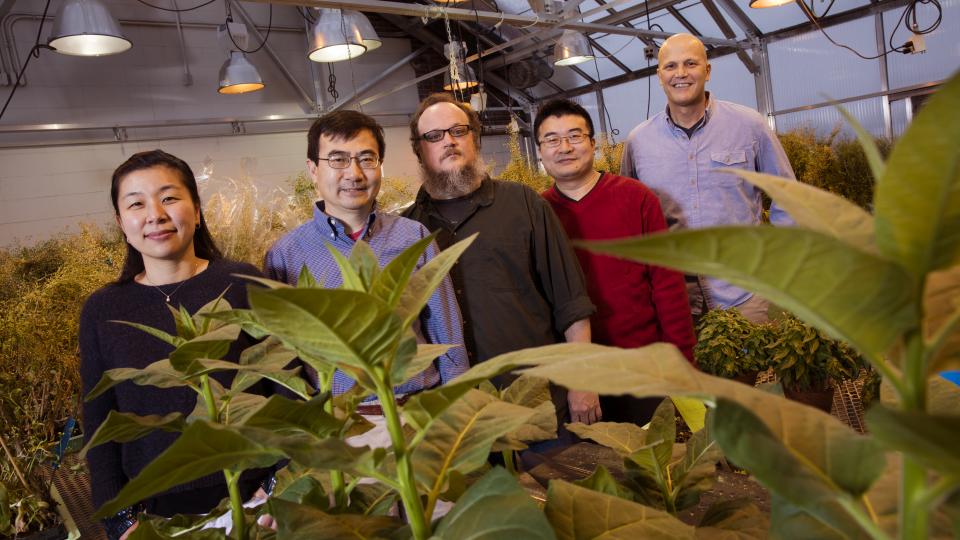Lincoln, Nebraska, USA
January 26, 2016

A team of UNL researchers led by Jim Alfano of the Center for Plant Science Innovation and the Department of Plant Pathology have identified a target of disease-causing plant pathogens. Their findings were recently published in the research journal Cell Host and Microbe. From left are Panya Kim, Ming Guo, Christian Elowsky, Guangyong Li and Alfano. (Craig Chandler/University Communications)
A new study from a University of Nebraska-Lincoln research team led by plant pathologist Jim Alfano found that a bacterial plant pathogen suppresses a plant's immune system through the action of a protein called HopE1.
While most bacteria are harmless, some inject weapons called type III effectors into plant cells to suppress a plant's immune system. Through millions of years of co-evolution, pathogens identify weak links in the immune system of the plant to target, making the plant more susceptible to disease.
"If we can better understand and improve plants' immune systems, we can help increase disease resistance and improve crop quality and yields," said Alfano, a Charles Bessey Professor of Plant Pathology.
The study focuses on the bacterial pathogen Pseudomonas syringae. This pathogen uses a specialized protein secretion system called the type III system, which is essentially a microsyringe, to inject bacterial type III effector proteins into plant cells. Alfano and the team have been studying different type III effectors injected into plant cells and have been identifying which parts of the immune system they are targeting.
The researchers found that when HopE1 is injected into a cell, it interacts with the host plant's calmodulin calcium sensor. This sensor is normally activated during a plant's immune response to rising calcium levels in plant cells. However, the research team found that the sensor also drives HopE1 to bind with a plant protein called microtubule-associated protein 65, or MAP65.
The interaction with MAP65 is significant because MAP65 plays an important role in the plant microtubule network, which is known to be involved in cell division and cell growth in higher organisms. Alfano's research group found that when HopE1 binds to MAP65, it separates the protein from the microtubule network. This chain of events results in a defective immune system, suggesting that the microtubule network is linked to immunity.
When pathogens inject effectors such as HopE1 into plant cells, it prevents the plant from secreting immunity-related products and ultimately leads to plant diseases. HopE1 is just one of many effectors the research team is studying in hope of identifying new components of plant immunity, which could lead to improved disease resistance in agricultural crops.
In addition to Alfano, the study was authored by Ming Guo and Guangyong Li of the Center for Plant Science Innovation and the Department of Plant Pathology, Panya Kim of the Center for Plant Science Innovation and the School of Biological Sciences and Christian Elowsky of the Center for Biotechnology. It was published in the journal Cell Host and Microbe.
A new study from a University of Nebraska-Lincoln research team led by plant pathologist Jim Alfano found that a bacterial plant pathogen suppresses a plant's immune system through the action of a protein called HopE1. - See more at: http://ianrnews.unl.edu/unl-researchers-identify-target-disease-causing-plant-pathogens#sthash.Cgn25bDp.dpuf